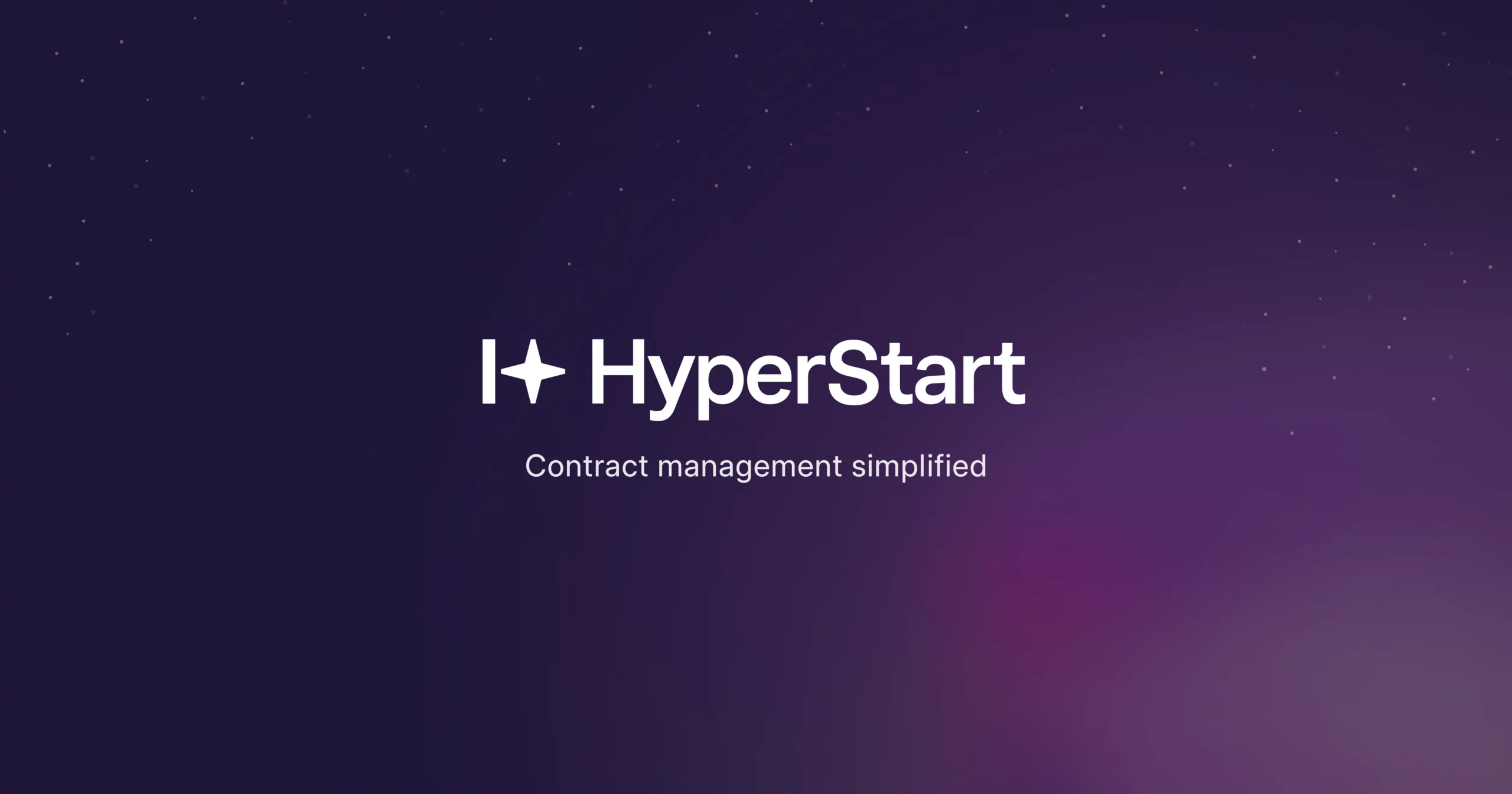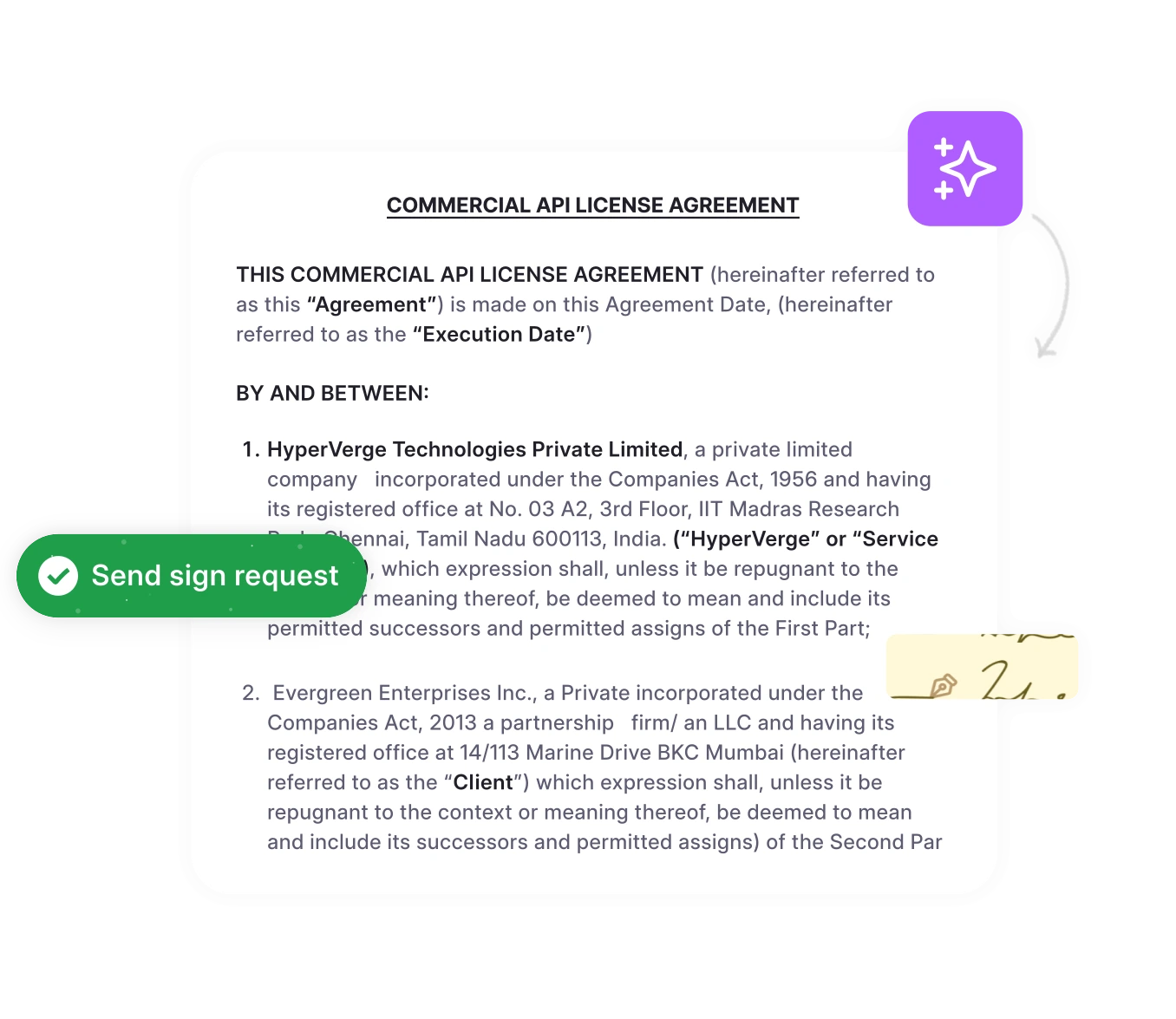Legal teams managing the referral partner agreement often face operational chaos — struggling to track commission structures, renewal dates, and compliance obligations.
According to Nielsen research cited by AnnexCloud, referral marketing drives over $6 trillion in annual consumer spending, with 92% of consumers trusting recommendations from people they know more than any other form of marketing. Yet manual referral agreement management creates missed payments, compliance risks, and administrative burdens that legal teams can’t afford.
Digital contracting transforms referral operations from disorganized complexity to streamlined efficiency — enabling legal professionals to focus on strategic partnership growth instead of administrative tasks.
What is a referral agreement?
A referral agreement is a legally binding contract that defines the terms of a partnership between two parties, where one party (the referrer) introduces qualified leads to another (the service provider) in exchange for a commission, fee, or other agreed-upon reward.
According to research compiled by ReferMeIQ from Deloitte, Nielsen, and Influitive, organizations with structured referral programs close deals faster, achieve higher customer lifetime value, and experience stronger retention rates. This measurable impact makes formal referral agreements a cornerstone of predictable business growth through strategic partnerships.
Example:
Imagine a software development company partnering with a digital marketing agency. The agency refers potential clients who need app development services. Each time a referred lead converts into a paying customer, the software company pays the agency a 10% referral commission on the value of the first project.
This agreement would clearly outline:
- What qualifies as a valid referral(e.g., a prospect who signs a contract within 90 days)
- The commission structure(percentage or flat fee)
- Payment timelines(e.g., within 30 days after invoice)
- Confidentiality and non-solicitation terms
- Termination conditions for ending the partnership
Unlike informal word-of-mouth recommendations, a referral agreement formalizes these terms to protect both parties, ensuring transparency, compliance, and accountability while maximizing the value of each partnership.
Take the hassle out of drafting referral agreements! Use our ready-to-use, legally-informed template to formalize partnerships, track commissions, and protect your business.
What’s included:
- Valid referral definitions and criteria
- Commission structures (percentage or flat fee)
- Payment timelines and obligations
- Confidentiality, non-solicitation, and IP clauses
- Termination and compliance terms
[Get Template]
Start formalizing your referral partnerships today
Who should use a referral agreement?
Referral agreements are ideal for businesses and individuals who rely on client or lead referrals to drive growth. They create a formal framework that ensures both parties understand their responsibilities, compensation, and performance expectations.
Typical scenarios where referral agreements are beneficial include:
- Complementary Businesses
Businesses offering non-competing but complementary services can partner through referral agreements to expand their reach. Example: A web design agency refers clients to a digital marketing firm, while the marketing firm refers clients needing website design back to the agency. Both businesses benefit from new leads and a broader audience without direct competition. - Industry Influencers
Bloggers, brand ambassadors, social media personalities, or other experts with a relevant audience can act as effective referral partners. Example: A fitness influencer partners with a sports nutritionist to recommend their meal plans and supplements to followers. The influencer earns a commission for each new customer who signs up through their referral link. - Professional Services
Law firms, accounting firms, consultants, or real estate agents can formalize partnerships with other service providers to cross-refer clients. Example: A real estate agent refers a client to a mortgage broker, and the broker refers clients in need of real estate services back to the agent. - Software and Technology Companies
SaaS companies often create referral programs to incentivize partners or resellers to bring in new users. Example: A project management software provider offers a commission to tech consultants who refer companies that sign up for an annual subscription.
By using a referral agreement, all parties have clear expectations, defined compensation, and legal protection, thereby transforming informal referrals into reliable and trackable channels for business growth.
What are the main types of referral agreements?
The 4 main types of referral agreements vary based on structure and qualification requirements:
1. Qualified referrals
Qualified referrals involve leads that have been pre-vetted by the referrer. This means the referrer has already assessed the prospect’s interest, needs, and suitability before sending them to the service provider.
Example: A marketing agency refers to a company that has explicitly expressed interest in developing a mobile app. The agency confirms the company’s budget and timeline before submitting the referral.
Advantages:
- Higher conversion rates since leads are already interested.
- Reduces time and effort for the service provider’s sales team.
- Builds trust and credibility between referrer and service provider.
2. Unqualified referrals
Unqualified referrals consist of basic contact information for potential leads, but the service provider must perform the initial qualification. The referrer may provide a list of prospects who are interested in the service.
Example: A business networking consultant provides a list of small businesses that could benefit from software consulting; however, the service provider must reach out to determine interest and suitability.
Advantages:
- Easier for referrers to participate, since no prior vetting is required.
- Can generate a larger volume of potential leads.
3. Commission structures
This type of referral agreement focuses primarily on how the referrer will be compensated. Commissions can be structured in different ways:
- The referrer receives a fixed amount for each new customer that converts.
- The referrer earns a percentage of revenue generated from the referred customer, often tied to the first project, initial sale, or recurring payments.
Example: A SaaS company offers a 15% commission on the first-year subscription to consultants who refer new clients.
Advantages:
- Provides clear incentives for referrers.
- Scales naturally with business growth.
4. Mutual referral agreements
Mutual referral agreements establish bidirectional partnerships, where both parties refer business to each other. These agreements are common between complementary companies seeking to grow through strategic collaboration.
Example: A web development firm and a digital marketing agency agree to refer clients to each other. When the marketing agency acquires a client needing a website, it refers them to the development firm, and vice versa.
Advantages:
- Strengthens long-term partnerships.
- Encourages collaborative growth rather than one-way incentives.
- Can open new markets and customer segments for both parties.
Benefits of Using a Referral Agreement
A well-structured referral agreement delivers clear advantages for businesses and partners by formalizing the referral process, building trust, and driving measurable growth. Here’s why organizations should use them:
1. Streamlined and Efficient Referral Process
A referral agreement defines each step of the referral process, including lead submission methods, response timelines, and responsibilities.
Example: A SaaS company partnering with a marketing agency specifies that leads must be submitted through a shared CRM system within 24 hours. This ensures that no leads are missed and follow-ups occur promptly, thereby improving conversion rates.
2. Transparent and Fair Compensation Structure
Referral agreements clarify commission percentages, flat fees, or milestone-based payments upfront. Both parties are aware of the exact calculation method for compensation and when it will be paid.
Example: A real estate agent referring clients to a mortgage broker receives 20% of the broker’s service fee for every successfully closed loan. This transparency prevents disputes and motivates consistent referrals.
3. Increased Client Acquisition and Revenue Growth
By leveraging trusted partners, businesses can gain access to new audiences without incurring significant marketing expenses. Referrals often convert faster because they come from credible, existing networks.
Example: A law firm establishes a referral program with accounting firms. Clients requiring legal advice are referred directly, resulting in faster onboarding, higher client retention rates, and increased revenue.
4. Enhanced Credibility and Trust with Prospects
Referrals from respected partners act as endorsements, giving potential clients confidence in the product or service. This credibility can shorten the sales cycle and improve client satisfaction.
Example: A software consultancy referred by an industry influencer gains immediate trust with prospects, resulting in higher engagement and a stronger market reputation.
5. Strengthened Long-Term Business Relationships
Referral agreements establish a formal framework for collaboration, encouraging partners to invest in the relationship for mutual benefit and success. Clear expectations reduce misunderstandings and foster loyalty.
Example: A marketing agency and a web design firm agree on a referral program with quarterly performance reviews. Both parties gain steady business, share insights, and refine strategies over time, leading to sustained growth for both companies.
6. Legal Protection and Reduced Risk
A formal agreement protects both parties from contract disputes related to commission, lead ownership, or confidentiality. It also ensures compliance with industry regulations, such as professional conduct rules for lawyers or financial advisors.
Example: An accounting firm that refers clients to a financial software provider includes a non-solicitation clause and confidentiality terms in the referral agreement, thereby safeguarding client data and ensuring regulatory contract compliance.
7. Scalable and Repeatable Growth Strategy
Referral agreements allow businesses to systematize partnerships, making it easier to replicate successful programs with multiple partners and across different markets.
Example: A SaaS company develops a standard referral agreement template and rolls it out to regional resellers. This ensures consistent processes, performance tracking, and predictable revenue across territories.
What are the essential components of a referral agreement template?
A comprehensive referral agreement template must include core legal elements that make the contract enforceable and protect both parties.
The elements of a contract establish the foundation: clear identification of parties, consideration (the commission or fee structure), defined duration or term length, and explicit acceptance mechanisms that create binding obligations.
The 6 core legal elements that form a contract’s foundation
- Offer
One party makes a clear and definite proposal, outlining the terms and conditions intended to form the basis of the agreement.
- Acceptance
The other party agrees to the offer without material changes, signifying mutual understanding and willingness to be bound by the proposed terms.
- Consideration
Each party exchanges something of value, which may include money, goods, services, or a promise; this mutual exchange is essential for the enforceability of the agreement.
- Capacity
All parties involved must have the legal capacity to enter into a contract—meaning they are of sound mind, of legal age, and not prohibited by law from engaging in the agreement.
- Legality
The contract’s purpose and terms must comply with applicable laws and public policies; agreements involving illegal activities are void and unenforceable.
- Intention to create legal relations
Both parties must genuinely intend the agreement to be legally binding, as opposed to informal arrangements or social promises.
Automate your agreement templates
HyperStart streamlines agreement creation with AI-powered templates and automated compliance tracking for faster closures.
Book a DemoHow to create and negotiate a referral partnership agreement
Creating an effective referral partnership agreement begins with a comprehensive needs assessment and a thorough evaluation of the partner. Contract drafting best practices require understanding both parties’ business models, target markets, and operational capabilities before finalizing terms.
Step 1: Needs assessment
Evaluate potential partner alignment, including target customer demographics, geographic coverage, and service complementarity.
Step 2: Template selection
Identify industry-specific requirements and regulatory considerations that impact contract structure.
Step 3: Legal review
Ensure compliance with professional conduct rules, licensing requirements, and applicable state and federal regulations.
Step 4: Negotiation strategy
Focus on mutually beneficial terms that create sustainable partnership value rather than one-sided advantages.
Best practices for referral agreements include documenting referral purpose, addressing barriers, and setting clear follow-up expectations.
– Read
What are the best practices for referral agreement management?
Effective referral agreement management requires standardized processes that scale across multiple partnerships while maintaining quality control and compliance monitoring. Service agreement best practices offer frameworks for efficiently managing complex partnership portfolios.
- Standardize referral agreement templates across various partnership types while allowing for customization to meet industry-specific requirements.
- Implement clear qualification criteria that prevent disputes and ensure both parties understand lead requirements and conversion expectations.
- Establish automated commission tracking systems that integrate with existing CRM platforms and financial management tools.
- Establish regular performance review schedules that maximize partnership value through data-driven insights and effective relationship management.
- Maintain detailed documentation and audit trails for compliance monitoring and dispute resolution procedures.
- Set up renewal alert systems that prevent missed opportunities and ensure continuous partnership value.
- Integrate referral tracking with existing business systems to provide real-time visibility into partnership performance and ROI.
- Define clear escalation procedures for dispute resolution that preserve professional relationships while addressing conflicts quickly.
- Schedule regular legal reviews to ensure ongoing compliance with changing regulations and professional conduct requirements.
- Set up additional compliance monitoring for attorney referral agreements to govern fee sharing and client solicitation. These partnerships require regular review of state bar requirements and ethical guidelines, which may change over time.
Ready to transform your contract management?
See how HyperStart automates contract agreement tracking, renewal alerts, and performance analytics for maximum contract value.
Book a DemoChallenges of Traditional Referral Agreement Management
Traditional referral agreement management creates operational chaos that legal teams struggle to control. Referral contracts scattered across departments and systems make it impossible to track renewal dates, monitor compliance requirements, or analyze partnership performance effectively.
1. Contract repository chaos
Occurs when agreements live across email threads, shared drives, and departmental folders without centralized organization. Legal teams waste hours searching for specific partnership terms, commission structures, or renewal dates that are often buried in unorganized file systems.
2. Missed renewal dates and commission payment deadlines
Damage professional relationships and create legal exposure. Manual tracking through spreadsheets and calendar reminders often fails at scale, particularly when managing dozens of active partnerships with varying terms and schedules.
3. Compliance monitoring difficulties
Multiply across jurisdictions and professional conduct requirements. Legal teams struggle to efficiently track regulatory changes, professional licensing updates, and industry-specific compliance requirements that impact existing partnerships.
4. Performance tracking limitations
Prevent data-driven optimization of partnership portfolios. Without centralized analytics, teams cannot identify high-performing partnerships, optimize commission structures, or eliminate underperforming relationships.
AI-powered automation transforms referral agreement management through intelligent contract analysis and automated workflow management. AI contract management platforms offer comprehensive solutions for managing the complexity of partnership contracts.
Organizations utilizing AI for contract lifecycle management have reduced their contract creation time by up to 82%, while improving compliance management and reducing litigation risks by 50%.
– Read
How AI-Powered CLM Transforms Referral Agreement Operations
AI-powered Contract Lifecycle Management (CLM) platforms solve these challenges by automating workflow, tracking, and analytics:
1. Centralized Contract Repository
AI organizes agreements into searchable, structured data. Legal teams can quickly access specific clauses, compare terms, and generate reports in seconds.
2. Automated Alerts and Tracking
AI monitors contract renewal dates, commission obligations, and performance metrics, preventing missed deadlines and errors that could harm relationships.
3. Real-Time Performance Analytics
AI provides insights into referral quality, ROI, and partnership trends, helping teams replicate successful patterns and eliminate underperforming agreements.
4. Metadata Extraction and Integration
Platforms like HyperStart extract key contract data from PDFs and integrate with Salesforce or other business systems, enabling real-time visibility within existing workflows.
5. Compliance Automation
Automated monitoring ensures contracts comply with industry regulations and professional conduct rules, reducing legal exposure.
6. Operational Efficiency and Strategic Focus
By eliminating manual tracking, teams achieve faster contract processing, maintain complete visibility of referral agreements, and focus on strategic partnership growth rather than administrative tasks.
Streamline your partnership contracts
Automate and centralize your entire referral agreement lifecycle with HyperStart’s AI-powered CLM platform for maximum efficiency.
Book a DemoTransform your referral agreement management with HyperStart
Legal teams shouldn’t have to deal with chaos when managing referral agreements. Manual tracking of partnership contracts often leads to missed opportunities, compliance risks, and administrative burdens—taking time and focus away from the strategic work that drives business growth.
HyperStart – contract management software changes the way referral agreements are managed. By combining advanced technology with legal expertise, the platform offers:
- Faster contract processing
- Automated renewal management to prevent missed deadlines
- Comprehensive compliance tracking that reduces legal exposure
Contract management teams using HyperStart see immediate operational improvements:
- Never miss a renewal date
- Automatically track referral commission obligations
- Maintain complete visibility into partnership performance across all agreements
By transforming referral agreements from scattered documents into a centralized, intelligent system, HyperStart enables legal professionals to focus on strategic partnership development rather than administrative tasks.











